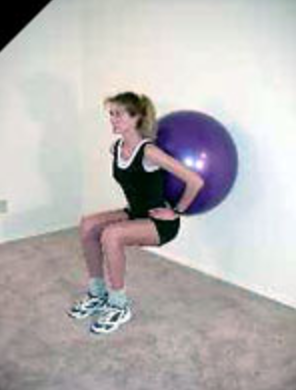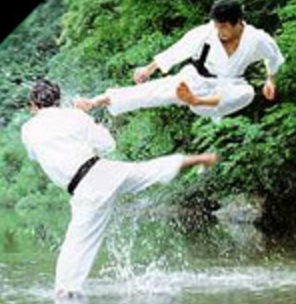Top Ten And-A-Half Training Tips for Martial Arts Conditioning
By: Alwyn Cosgrove
(excerpted from The Secrets of Martial Arts Conditioning)
Applying the principles of scientific training– I have come up with ten (and a half J ) training guidelines for the combat athlete that must be present to ensure competitive success.
1: Bodyweight before external resistance
 Many athletes make the mistake of beginning a strength routine and going straight for the heavy weights. This usually ends up causing an injury. An athlete has no business using load if he/she cannot stabilize, control and move efficiently with only their bodyweight. So your strength program in the beginning stages may actually include no weights whatsoever. And it will work better and faster than a typical program that relies primarily on weights and machines in the beginning stages. In fact in my experience I’d suggest that some athletes cannot even work with their bodyweight so we may need to modify certain exercises.
Many athletes make the mistake of beginning a strength routine and going straight for the heavy weights. This usually ends up causing an injury. An athlete has no business using load if he/she cannot stabilize, control and move efficiently with only their bodyweight. So your strength program in the beginning stages may actually include no weights whatsoever. And it will work better and faster than a typical program that relies primarily on weights and machines in the beginning stages. In fact in my experience I’d suggest that some athletes cannot even work with their bodyweight so we may need to modify certain exercises.
Do not rush to lift heavy loads – muscle recruitment and control are far more important than maximal strength for any athlete. Without control – the strength is useless.
2: Train to the 5th Power
This is a concept I learned from Juan Carlos Santana – basically it refers to the following.
1st – Train in a standing position – GROUND BASED.
The majority of athletic training should take place in an upright position – standing. Of course there are exceptions to this rule, but in general, we always lose something when we go from a standing position to a seated or lying position.
2nd – Train with free weights (destabilized)
Any machine limits the range of motion and controls the movement. This is fine for beginners, but athletes need to be able to stabilize and control their bodies in all three planes of motion simultaneously.
3rd – Use Multiple Joints (the kinetic CHAIN is natural)
Single joint strength (e.g. leg extension machine, bicep curls) develops useless strength – A study was undertaken at Ohio State involving a knee extension test. The participants included:
- 3 World ranked squatters
- 1 World Record holder in the squat
 The test results of the above subjects’ averaged 180lbs of force on the Cybex leg extension machine.
The test results of the above subjects’ averaged 180lbs of force on the Cybex leg extension machine.
However, a local power lifter (ranked 15th in the state) broke the machine. He wasn’t even number one in his state but he was stronger on this machine than the World ranked lifters. If there is a better example of the inability of single joint machine training to translate to real world strength then I’d like to see it. A guy who was only ranked 15th in the state can apply more single leg strength than a World Record holder. Nice. Pretty. But pretty useless. If that strength doesn’t transfer then what’s the point of having it?
Basically, despite the strength that individual exhibited on the machine, he was unable to apply it in a real world situation – like squatting. And the elite squatters weren’t that strong on the leg extension – showing it’s not even a factor.
So leg extension machines are a waste of time. Unless of course you compete in seated ass kicking leg extension contests
“How can anyone expect to possess co-ordination in active work when his muscles have never worked together in groups?”
– Earle Liederman 1924.
Nearly 80 years ago and we are still having this argument today. Isolation machines have no place in the preparation of a competitive athlete.
“Single -joint exercises, such as leg extensions and leg curls develop movement patterns that will interfere with patterns you use in sport. Such exercises lead to inappropriate muscle recruitment patterns that can impair movement and lead to injury”
– Thomas Fahey
4th -Train with explosiveness
Explosiveness as I see it can be defined as ‘as fast as possible with control’. Some people seem to feel that explosiveness is somewhat dangerous. Sloppy training, uncontrolled movements? That’s dangerous. Training explosively more closely mirrors what happens in sport and/or life.
5th – Train functionally – train movements not muscle
groups. Again, isolated muscle group training, outside of rehabilitation has no place in athletic training. An athlete should focus on strengthening specific movements. True muscle isolation is impossible anyway, so let’s focus on using that body to work in an integrated fashion.
3: Train unilaterally and multi-planar
-the majority of training programs take place in the sagittal plane with bilateral movements. Sport takes place in all 3 planes simultaneously with primarily unilateral movements
4: Use all primary methods to develop strength
Max Strength method – heavy loads
Repeated Efforts Method – multiple sets
Dynamic Effort Method – using relatively lighter weights and moving them at max speed (this is the least used method)
5: Variation
Everyone seems to understand that training load should be progressively increased
Few understand that the training stimulus must also be progressively and periodically varied
All programs have positive and negative aspects no matter how well designed or specific – too much time on one program and you’ll habituate to the positive aspects and accumulate the negative aspects
6: Avoid mimicking skills
The role of conditioning training is NOT skill training. Loading a technique tends to affect the mechanics of the technique negatively.
7: Train with Balance
Balance between motor qualities
Balance between movement patterns (e.g. horizontal push-pull)
8: Focus on Rate of Force Development.
Either lift lighter weights fast, or heavy weights as fast as possible (intent is more important than actual speed
9: Train the antagonists
 The speed of a kick or punch is determined largely by the ability of the antagonist to eccentrically decelerate the joint action efficiently and prevent joint injury. If your body cannot safely and effectively – brake – the motion, then it will not allow you to achieve full acceleration.
The speed of a kick or punch is determined largely by the ability of the antagonist to eccentrically decelerate the joint action efficiently and prevent joint injury. If your body cannot safely and effectively – brake – the motion, then it will not allow you to achieve full acceleration.
If you are not training the antagonists eccentrically – you are not training deceleration. And if you are not training deceleration you cannot be training acceleration.
Think about it – how fast would you drive your car if you knew your brakes were not working at their best?
10: No Aerobic Training
Aerobic training is pretty much a total waste of time. There is nothing in any martial art that is done aerobically – it is done at high intensity, explosively and at full speed – usually without oxygen. Martial arts take place at the limits of the anaerobic threshold – there is no benefit to doing long slow training of any kind.
10.5: Use Undulating Periodization
When using linear models – we tend to lose the qualities we initially sought to improve
E.g. 6 weeks of hypertrophy, 6 weeks of strength. 6 weeks of speed strength
At this point it has been 12 weeks since we were exposed to hypertrophy methods – so we’ll have lost portions of that quality A better method is to alternate accumulation and intensification phases.
Typical mistakes 1) Sacrificing Quality for Quantity: Don’t do more of something until you can do it well. More is not better. BETTER is BETTER 2) Seeking fatigue / soreness The effectiveness of training is not determined by the amount of fatigue it produces but by the degree to which it improves the qualities and/or abilities you’re trying to develop. 3) Excessive focus on loading Too much focus on the loads and not how it is being moved, and whether or not there is optimal transfer (standing split stance cable press v barbell bench press). Also the time taken to go from a 300lb squat to a 400lb squat may not be worth the return in the real world. 4) Lack of diversity : Unchanging routines leads to staleness and overuse injuries 5) Lack of continuity Write programs not workouts – try to write 12-16 weeks at a time. Understand that certain factors may mean that you need to change your routines – that’s ok. However – what I typically see is a situation where trainers and coaches do not write long term plans, they write single workouts. This leads to a lack of continuity and progress. Remember the ironic rule of strength training for sport. The objective is not to get stronger per se but to improve athletic performance. Do not get caught up in the numbers game and do not confuse gym improvements with real world or sports world improvements. The greatest athletes in the world do not necessarily have the greatest bench presses in the world. The greatest athletes in the world have an ability to produce useable force on their field of play. Usable force is force that propels athletes towards the ball, knocks another athlete back or down, helps you move at full speed, or throws the winning touchdown pass. Usable force is force properly directed in an unstable real world, unpredictable environment. The weight room, in general, is a stable environment whereas a field of play or the competition ring is a constantly changing place. A good strength and conditioning coach looks to improve athletic performances – not just gym lift numbers.
About the Author:
Alywn Cosgrove, born in Scotland and initially exposed to fitness training through an intense competitive sport martial arts background, Alwyn Cosgrove began reading and studying any training related material he could get his hands on. This led Alwyn to formal academic studies in Sports Performance at West Lothian College and then progressed on to receiving an honors degree in Sports Science from Chester College, the University of Liverpool. During his career as a fitness coach, Alwyn began with assisting in martial arts lessons in 1986 and teaching fitness classes in 1989, and has studied under all of the top fitness professionals and coaches in the world and has worked with a wide variety of clientele, from general population clientele to several top level athletes, World Champions and professionals in a multitude of sports. A sought after ‘expert’ for several of the country’s leading publications including a regular contributor to Men’s Health magazine, Alwyn has co-authored two books in the “New Rules of Lifting” series (with a third on the way) and currently spends his time training clients, training his staff at Results Fitness, speaking on the lecture circuit and coaching fitness trainers worldwide in their businesses.
For the past decade, with his wife Rachel, Alwyn runs Results Fitness in Santa Clarita, California- which has twice been named one of America’s Top Gyms by Men’s Health magazine, a gym which specializes in programs for real-world busy people, and prides itself on “changing the way fitness is done – period!”
Recommended Athletes’ Acceleration Products


0 Comments for “Top Ten And-A-Half Training Tips for Martial Arts Conditioning”